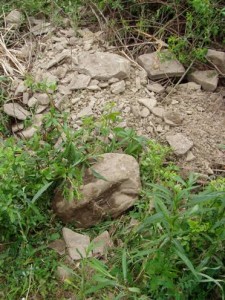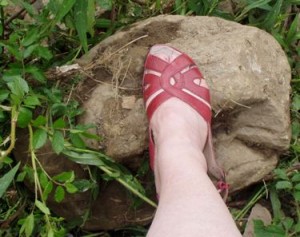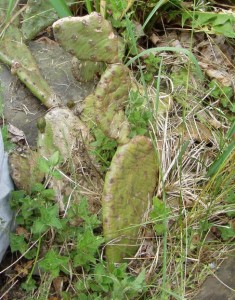 In our last episode, the DH and I (well, mostly the DH) were ripping up a grass strip that’s between two other vegetable garden beds to make another vegetable garden bed.New Garden bed the hard way And your Aunt Toby wanted you to know that we find all sorts of things that former owners have buried in the ground when we do this. We once found what was obviously the spot for the burn barrel (or whatever the former owner used to burn their garbage) and in our digging, we pulled out everything from pristine glass milk bottles to broken china to a leaf spring from a car. It’s really quite amazing.
In our last episode, the DH and I (well, mostly the DH) were ripping up a grass strip that’s between two other vegetable garden beds to make another vegetable garden bed.New Garden bed the hard way And your Aunt Toby wanted you to know that we find all sorts of things that former owners have buried in the ground when we do this. We once found what was obviously the spot for the burn barrel (or whatever the former owner used to burn their garbage) and in our digging, we pulled out everything from pristine glass milk bottles to broken china to a leaf spring from a car. It’s really quite amazing.
But mostly, as you see from the top, we pull out rocks. Lots and lots of rocks. Some of them are shockingly big, actually.
 The one at the bottom of the picture measured (roughly; I was using a carpenter’s metal tape so this is just length by width by height): 18″ by 13″ by 10″ and probably weighed a good 40-50 pounds. My foot is there just to give you an idea as to how big it was (and the red sandals are by Bass Shoes – thank you for asking). It also required the DH’s rolling it out of the bed and up an earthen ramp to get it out. Very Stone Henge and all that.
The one at the bottom of the picture measured (roughly; I was using a carpenter’s metal tape so this is just length by width by height): 18″ by 13″ by 10″ and probably weighed a good 40-50 pounds. My foot is there just to give you an idea as to how big it was (and the red sandals are by Bass Shoes – thank you for asking). It also required the DH’s rolling it out of the bed and up an earthen ramp to get it out. Very Stone Henge and all that.
Rolling is a lot easier on the arms, legs and the back than trying to lift a rock (we should have consulted with “Pharoah’s Pyramid Builders and Large Statue Moving, Inc.’ before we did this). Oh, I suppose with enough horsepower and a chain, we could have pulled it out but turn around space there is at a premium (the property definitely ‘drops off’ in a rather inconvenient way close to the garden and we have had to call for a ‘all hands on deck’ to push it back up when we got too close to the edge), so rolling the thing out seemed to be the best way to go and doing that worked very well (and we avoided injuries, too). But the sheer number and size of rocks and slabs of shale that have come out of that bed (and the DH is only 2/3 finished) is truly amazing to me. Rocks take up a tremendous amount of space so taking them out (if nothing else) will give us more room for more compost.
 Another item from the garden which I stumbled over (literally) but which does not necessarily rate its own blog post is this plant here. This is an opuntia, a cold hardy (and when I say ‘cold hardy’ I mean ‘cold hardy here at Chez Siberia, which means that unless you live at Hudson’s Bay, Canada, it should be hardy for you as well) cactus which is native to the southern half of Canada. As a matter of fact, there are several of these covered in this article here: Cold Hardy Cacti in Canada Most are hardy to Zone 4 but there is at least one which is Zone (brrrrr) 2.
Another item from the garden which I stumbled over (literally) but which does not necessarily rate its own blog post is this plant here. This is an opuntia, a cold hardy (and when I say ‘cold hardy’ I mean ‘cold hardy here at Chez Siberia, which means that unless you live at Hudson’s Bay, Canada, it should be hardy for you as well) cactus which is native to the southern half of Canada. As a matter of fact, there are several of these covered in this article here: Cold Hardy Cacti in Canada Most are hardy to Zone 4 but there is at least one which is Zone (brrrrr) 2.
Just a note on this one – it has big 3″ yellow flowers with red centers. Very showy. It also has extremely nasty spines AND it has structures referred to (by cacti aficionados) as glochids. These are rather innocent looking fine short hair-like structures that surround the base of the spines. The spines are showy enough that you think that you can avoid getting stuck if you put your fingers in the right spots.
Let me warn you right now – the spines are bad, but those innocent looking little hairs are far, far worse because they detach from the plant rather easily and then get stuck under your skin and fingernails and are the devil to get out because they are rather like fish hooks. Brushing them off just forces them under the outer layer or your skin. So, wear gloves.
You have been warned.
The other thing and the photo really illustrates this – these are not fussy plants. This is not one of those ‘requires free-draining planting site; bury roots in number whatever-it-is gravel and xxxx’. Literally, I stuck one of the pads from another plant I had between two rocks in a bit of a rock garden which I rather negligently have at the back of the veggie patches and it took root. And a good thing I did that also since the landscaper dug up the original and removed it(despite my instructions to the contrary; let that be a lesson to you – never, ever believe that when a landscaper tells you ‘oh, yes; we will save all the plants from that side of the house when we do all of this work so that you can replant them elsewhere,’ that this is what they will do. Unless you are standing there with your diagram and list to point in a specific direction and say “dig xxx up and put it under that tree there’, they will dig everything up including your prize-winning irises and throw everything higglety-pigglety into the back of the truck along with the tools, equipment, the workmen’s lunchboxes and six pack coolers and you will never see any of it again). So at least I have this and one of these days, I’ll move it to a move attractive spot, but for the moment, it is rather content in this neglected area, surrounded by weeds and quack grass. The other warning is that these plants get rather large and sprawling, so give it about 18” of room in all directions and perhaps some rather large rocks to sprawl upon so that it looks more languorous and Hollywood starlet-like rather than the untidy slattern that it generally is.

Rocks! My local Jewish community is like the joke about the guy rescued from the desert island: “This shul is where I pray; that shul I wouldn’t be caught dead in!” Not only are there 2 shuls, there are 2 cemeteries. The 2 cemeteries *look* like one, with a common fence, but everyone knows where the dividing line is. “Our side” is a sandy loam, so it’s a little tricky to dig a grave, except in the dead of winter (groan – sorry), when we have to use a jackhammer. But their side is mostly rocks. Oy. At Jewish funerals, the assembled company fills in the grave. No death-defying leaving it to the funeral director and the grave diggers for us. It’s bad enough when those first shovelfuls of sandy loam hit the coffin with a thud. But on “their side” with the rocks…! Some of them are so big that I’m amazed they haven’t broken the coffin. Rocks in New England!